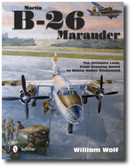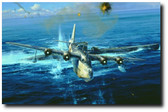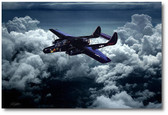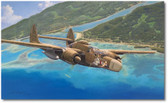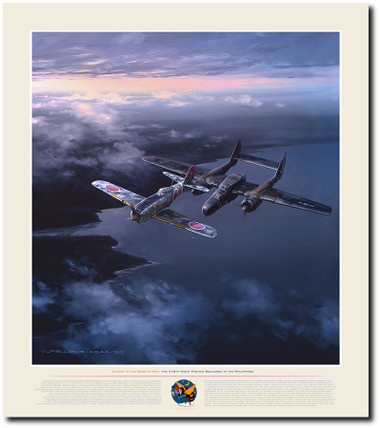 Loading... Please wait...
Loading... Please wait...- Home
- Aviation Art - By Artist
- Caught in the Widow's Web
- Home
- Aviation Art - By Artist
- Jack Fellows
- Caught in the Widow's Web
Categories
Caught in the Widow's Web
Product Description
L/E of 199 Giclee Prints $200.00
A/P on paper or Canvas (comes rolled) $285.00
S/N by the Artist
Image Size: 20" x 21"
Paper Size: 24" x 27"
Plane Type:P-61 Black Widow
During the night and early morning hours of 29-30 December, Major Carroll Cecil (Snuffy) Smith became the top-scoring night fighter pilot of all of the United States Army Air Forces, in all theaters during WWII in the skies over Mindoro Island, Philippines Territory. Depicted above is the final moment prior to Smith leveling-out directly behind the Ki-84 being flown by Imperial Japanese Army 29th Air Regiment pilot, Sgt. Akira Kusano, and firing the Black Widows four deadly 20 mm cannon at point-blank range. Kusano was completely unaware of the danger, which was underneath his aircraft in the early morning light, one mile above Mindoro. Major Smith, commanding officer of the 418th Night Fighter Squadron was tasked with tackling the many Japanese night intruders, which had been interfering with the Armys efforts to establish airfields on Mindoro. On this night major Smiths radar operator, Lt. Phil Porter, vectored him toward a contact which turned out to be an Irving upon making visual contact. Smith shot this one down in flames, creating a welcome show for the men on the Allied ships below that had been bearing the brunt of over 400 Japanese sorties flown into the area between 18 December and 7 January (1945) in opposition to the landings and against the supporting ships. Shortly thereafter, Smith was vectored to another radar contact which also turned out to be an Irving. This one was also destroyed after visual contact had been made. After returning to base to refuel, Smiths P-61 was hurriedly returned to patrol, without even replacing the 20 mm ammunition which had been used earlier since Smith felt that it was unlikely that they would encounter additional Japanese aircraft. However, shortly after returning to his patrol area Smith was again vectored toward a bogey which was slowly flying at only 500 feet above the water,a dangerous altitude to accomplish an interception on a very dark, moonless night. This contact was a Rufe floatplane, which exploded after a short burst of 20 mm and dove into the sea. Less than an hour later Smith was vectored to the nights fourth bogey, as dawn approached. By the time contact was made it was almost full daylight and Smith was unsure of how much 20 mm ordinance remained on-board. This contact was the Ki-84 Frank depicted above, and although Smith had not seen one before, he knew instantly what it was. The Ki-84 was the best fighter aircraft in the Japanese Army Air Force, Successor to the Ki-43 and very dangerous, should its pilot become aware of Smiths approach. Because of this and the fact that Smith was unsure of how much ammunition remained for his use, he closed the range to point-blank before firing: I stayed below and closed to 75 feet. I opened fire and saw the awesome results of four 20 mm cannon hitting an aircraft. The Frank simply disintegrated, and the pieces flew into the sea, with me trying to avoid the Debris ...Smith flew P-70s (Douglas A-20s converted to night fighters) B-25s and converted P-38s while assigned to the 418th NFS. His first two confirmed aerial victories were in the P-38 but Smith said that the Black Widow was always his favorite, PLANE JUNKIE - CAUGHT IN THE WIDOWS WEB the 418th Night Fighter Squadron in the Philippines by Jack Fellows (P-61 Black Widow)

